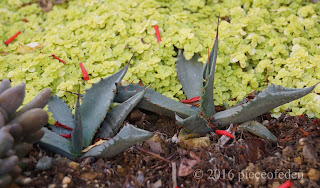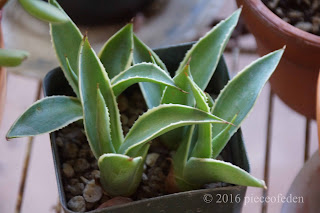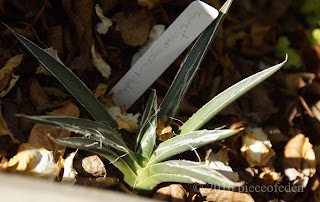All the Agaves: fifty five different kinds, give or take a few. Because there are so many, the photos are in "small" format--if you want a closer look, click on each photo to enlarge.
Agave albopilosa and a dwarf, rapidly offsetting form of Agave victoriae-reginae:
Agave americana 'Medio Picta Aurea'. I've been expecting it to bloom for two or three years, but it pups on.
Agave asperrima (aka A. scabra), tiny rootless offsets picked up in Phoenix. Now rooted, where to put them?
Agave attenuata 'Karas Stripes'--not particularly stripe-y--you can just make out a few here and there
Agave 'Blue Flame', looking green, is still settling in after a move.
This 'Blue Flame' needs to be moved. I went looking for it to move it, and couldn't find it. There it is!
This is the striated form of 'Blue Flame'. Unfortunately it has been a weak grower.
'Blue Glow', a favorite. These are close to blooming, unfortunately. If this plant never bloomed, it would be absolutely totally perfect. But no plant is, so it must bloom and die.
The white-edged variant, 'Snow Glow'. The photo shows how planting on a slope affects the shape.
The yellow-edged variant, 'Sun Glow', also affected by being grown on a slope. In nature many species of Agaves are found on slopes, or growing from fissures in cliffs. Slopes are natural habitat for them.
This is 'Blue Ember' from Rancho Soledad, damaged by this summer's intense heat. I expected to see it for retail sale, never did, so I'm glad I bought one when I saw it.
A. bracteosa marginated, 'Ivory Frost', in full shade. It needs a better spot. Must move. I placed it here when it was very small, at the start of a long dry summer, so it would survive.
Some of the many A. desmetianas. When the inflorescences start producing plantlets, there will be thousands. This species was the first one we got for the garden. These plants were plantlets from the blooms of the first.
These next three were super-variegated plantlets from the same bloom as the above big plants. This illustrates how variegation will dramatically slow a plant's growth.
There were about a dozen fully variegated plantlets, but only these three retained that trait.
The beautiful desmetiana variant, 'Joe Hoak', still a favorite for its elegant shape and striking pale coloration. 'Joe Hoak' was also one of the first Agaves we purchased.
A. ellemetiana, growing in full shade. Similar to attenuata, with fewer but larger leaves.
A. gentryi 'Jaws' (Thanks, DM or was it KP?):
A. guiengola. The version with pale-yellow margins, 'Creme Brulee' is more common for some reason. For other some reason, I like the plain species more. The beauty is ruined by offsets, so I religiously pull them off. This is true of many Agave species--the offsets clutter the shape of the original plant. I prefer taxa of solitary habit. In cultivation, many though not all solitaries will produce an offset or two--just enough for replacement or gifts.
A. gypsophila 'Ivory Curls'. Another favorite.
The plain version of gypsophila. It's nice, too--'Ivory Curls' is just better.
A. havardiana. Extremely slow-growing, it's a beautiful species when it reaches mature size. Still small after several years in the ground, it is recovering from having been engulfed by a clump of fast spreading Cistanthe.
A. horrida ssp. perotensis. Sweet!
'Kissho Kan', a variant of potatorum (Thanks, AZ!):
A. lophantha 'Fatal Attraction', in exile on the balcony because lophantha offsets like crazy. If you don't believe me...
...consider A. lophantha 'Quadricolor'. Yes, it offsets like crazy, but this has proven to be a perfect small Agave for the near-vertical section of the east side slope--it holds the slope firmly, and the rosettes grow and looks beautiful on rainfall alone--rainfall which this past year was a measly 6". Pup on!
Update: I knew I'd miss at least one. Unintentionally omitted was Agave macroacantha 'Pablo's Choice', which can perform the same slope-filling service as A. lophantha. The terminal spines age to rich black, a delicious contrast to the blue foliage.
The from-a-farm-in-Vera-Cruz version of A. marmorata. Another favorite. Maybe the favorite.
On of its two offsets is thriving. The other needs to get out of the shade already!
Here's the other offset, out of the shade. It was a tiny thing when I pulled it off the original, the size of my little fingernail, so I planted it in full shade so it would survive summer. Now it has a tiny offset of its own. Because the plant was growing in shade, it is super blue.
Here's the Proven Winners version of marmorata. It's preparing to bloom at 6' tall and about 7' wide. It has one offset, hidden on the back side, ready to replace it.
Agave 'Mateo', possibly a cross of bracteosa and lophantha. This one has been growing roots in full shade, hence an odd look.
Another 'Mateo' (Thanks, GB!), this one also waiting in shade for a place in the sun in the ground where there is moisture, and nutrients. Things plants like.
A well-travelled Agave mitis var albidior, which started off in Davis, spent some time in Portland, returned, wet and chilled, to Davis, and is now recovering here. I think it's still wondering what happened.
Supposedly this next one is a cross of A. mitis (fast, wimpy) with A. montana (slow, hardy). It's a rich blue, bluer than the photo. Known as A. mitis 'Nova', it's a beautiful plant but very short-lived (3-4 years), though it produces a few offsets. (Note that Agave attenuata 'Nova' is a completely different plant.)
Minimal water slows down growth and extends its life span.
A. mitis (or celsii) 'Multicolor' is also short-lived. I have a whole shopping bag full of plantlets, (Thanks, KD!) if anyone is interested. From what I have read, this plant is not a variegated version of the true Agave mitis--it is different in leaf shape and flower. Apparently a plant of mysterious origins.
'Mr. Ripple' (Thanks, DM!), thought to be a cross between A. salmiana and A. americana ssp protoamericana. This one gets BIG. It's been given considerable space to become glorious.
A. nizandensis. Like A. bracteosa, the leaves are brittle and will snap off easily, so best left as undisturbed as possible. It is reported sensitive to over watering--not a problem in this garden.
Agave ovatifolia is one of several Agaves being overwhelmed by Leucospermum 'Yellow Bird', but it is the Agave possibly able to withstand the onslaught: big and getting bigger.
One of several A. parrasanas. Another slow growing beauty.
As the plant grows the leaves become more vertical
This is the variegated variant known as 'Fire Ball'. This particular plant doesn't have much variegation, but it's a beauty anyway.
Just a bit of yellow edging here and there, but ah, those impressions!
Always flawless A. parryi truncata. Never seems to get marked, spotted, or even dirty.
Here's the variegated version, which started out really green, purchased at the 2016 Inter-City Show. It has blued up as it has grown.
Agave x pumila needs out of that pot. A plant of mysterious origins. It may be A. lechuguilla × A. victoriae-reginae. There are a couple in the ground at the Huntington, looking really good (and surprisingly large).
Here's a big x pumila at the Huntington April 2015:
I'm tempted to plant mine in the ground, to see if it can develop that kind of size. It may need protection from winter rains (if we ever get any) as it is said to be sensitive to water from above.
Agave pygmae 'Dragon Toes'. Another very pretty plant. Its sole offset can be seen at upper-ish right.
'Royal Spine' (Thanks, GB!)
Sold as Agave salmiana 'Medio Picta', this one has been slow slow slow, but it's a looker, and has produced a few offsets.
Offset!
Agave sebastiana 'Silver Lining' is said to be extremely xeric, but it has struggled in a dry spot. I tweaked the irrigation so sebastiana would get some water--hopefully it will help.
Agave 'Shadow Dancer' is said to be a variant of a cross between A. filifera and A. mitis var albidior.
I had bought a trio of Agave stricta var nana. One bloomed, then I pulled out all three--this was the sole offset of one. It's healthier than it looks--it was overwhelmed by Leucadendron linearifolia all summer--I've been trimming back the Leucadendron to give the Agave some sun.
Aloe titanota from Bach's in AZ. To its upper left is a more blue selection, another plant being engulfed by Leucospermum 'Yellow Bird'. The Leucospermum is growing like mad and forming flower buds like mad and will present a stunning show come late March.
Agave titanota 'White Ice'
Agave titanota 'Wanky Lanky', a green dwarf version
Agave toumeyana 'Bella' (Thanks, GB!), planted in shade until it can do some growing. This has worked out well--tiny plants can't handle full sun even here near the coast.
Agave victoriae-reginae. Another slow grower, this one like A. havardiana is at its most beautiful when it reaches mature size.
Agave vilmoriniana 'Stained Glass', another favorite, with those elegant curving leaves. A neighbor has an enormous and far more gorgeous specimen, which I am entirely justified in envying. Must get a good photo of that one, for your viewing pleasure.
I have a lot of favorites in this genus. A couple that would be nice to have are bovicornuta and colorata--have not yet found the plants at the right size (small) and price (small) to buy. Sometime.
With this much beauty to admire, I'm good for a while.































































Nice collection. What makes you think your Agave x 'Pumila' isn't just Agave pumila? Sure looks like what I grow as Agave pumila.
ReplyDeletesorry, ''s in the wrong plant name. Too much typing on this post. Corrected to Agave x pumila. This as far as I have read is not a species but a natural hybrid or very old hybrid hence of course the "x". If you have newer/further info, I'd love to know!
DeleteSan Marcos:
"in fact, its entire origin is quite a mystery. The neotype specimen used by Howard Scott Gentry to describe this plant in 1963 for his book “Agaves of Continental North America” was a plant in cultivation at the Huntington Botanic Garden. Gentry noted that when John Baker first described this plant in 1888 he did so from a plant growing at the Royal Horticultural Gardens at Kew which had been obtained from De Smet, a Dutch plant trader, in 1879. Gentry speculated that if it were of hybrid origin that he would suspect it a cross between Agave lechuguilla and Agave victoriae-reginae and in his book he includes a statement from Charlie Glass agreeing with this hypothesis and noting that if this were the case that he thought it might be from the north edge of Laguna de la Viesca where a dwarf form of Agave victoriae-reginae and Agave lechuguilla were both collected. "
Saw some quite impressively large specimens, the largest I have seen, recently planted at the Huntington Desert Garden entrance, I'll have to look for the photos.
spelled toumeyana wrong too
DeleteInteresting. I never knew this. You are right:
Deletehttp://apps.kew.org/wcsp/advsearch.do;jsessionid=0C63677ECBD3DBEE15658F007E5DEE44
A. asperrima × A. nickelsiae
Thanks for that link! Even more mystery--is it A. asperrima x A. nickelsiae or A. lechuguilla x A. v-r?!?
DeleteWhat a massive and varied collection you have! Your 'Jaws' must have come from Denise as mine has produced just one pup, still growing in my garden but gaining size surprisingly fast. Meanwhile, my 'Quadricolors' have been slow to grow and slow to pup - maybe I should move them to my back slope! I'm enjoying the 3 'Medio Picta' you passed along last year - they've finally decided to get growing.
ReplyDeleteThe rain we are getting might get those 'Quadricolors' going. :) My barrels runneth over!
DeleteHappy you are getting some use out of the 'Medio Picta's. I was looking up at mine today and saw a whole lot of new offsets that need to be removed again. Too many!
What a splendid collection Hoov ! And that Joe Hoak is just a stunner. This post will be a great reference to come back to for both you and your readers.
ReplyDeleteYes I can look back and say, "What, only fifty five different kinds? Those were the days." ;^)
DeleteMy Joe Hoak suffered a huge branch of the neighbor's candelabra euphorb crashing down from over the fence, directly on its pristine rosette, which is definitely pristine no more. Luckily, there's another smaller one elsewhere -- typical agave lover's response to tragedy! I've also got a thriving colony of Quadricolor going that I mean to thin -- but it's as mesmerizing as starfish mulitplying so I leave them alone. Love your collection. I've just noticed my colorata is sending out a runner, so I'll pot it up asap.
ReplyDeleteOh, sorry to hear Joe was attacked. :( He's good about producing a few offsets, damaged or not. Free branch of a Euphorb is nice, but that is a hard way to get it.
DeleteQuadricolor manages to stay unspotted, un-scarred and not brown-tipped despite rain irrigation alone--I'm more and more impressed with it as time passes. Colorata! Ooooh!
A regular rogue's gallery of spiky characters. I especially like 'Medico Picta'...so graceful, even as a pup.
ReplyDeleteThe leaves do have a graceful sweep--helps me to overlook the too-plentiful pupping.
DeleteI love agaves. The variety of your collection is stunning, thank you for sharing.
ReplyDeleteGlad you enjoyed it! :)
DeleteI saved this post for when I had the time to slowly, oh so slowly, page down and savor every beautiful photo. Now I'm researching ticket prices so I can come visit your garden! (kidding, only slightly).
ReplyDeleteThat Agave mitis that traveled up the coast and back down again...I'm glad it's finally found a home. Both you and Gerhard look to have treated it kindly.
You are always welcome here! Glad you enjoyed the post.
DeleteThe mitis albidior is basking in warm sun today. I get the sense it will be okay. :)
That A. mitis albidior is a true co-production of Danger Garden, Succulents and More, and Piece of Eden!
DeleteWhich is super cool!
DeleteI'm afraid my only contribution was pushing it close to death...
DeleteAwww. It was the climate, not you!
DeleteI'm so glad you've followed up your comprehensive aloe inventory with an agave version. It's like Christmas came early :-).
ReplyDeleteAgave albopilosa: Not a fast grower in my experience. Mine started out as small as yours and now, three years later, seems to be picking up speed. Definitely worth the wait though!
Agave applanata 'Cream Spike': Not fast either but so much potential, esp. in the ground where it doesn't seem to produce nowhere near as many pups as it does in a container.
A. ellemetiana: I saw a plant in the UC Davis Arboretum this past Sunday that looked just like it. I didn't think it was hardy though. Gotta do some research.
A. guiengola 'Creme Brulee': Mine produced more pups than any other agave I've ever had. Possibly even more than A. americana. But I found it barely tolerated temps in the mid-30s, let alone below freezing (obviously not an issue where you are).
A. lophantha 'Fatal Attraction': I think 'Fatal Attraction' is A. funkiana. Not that it's easy to keep lophantha and funkiana apart (not sure I could).
A. marmorata (Vera Cruz clone): A true stunner. I wish it were hardy here AND I had the room...
A. 'Nova': Interesting to hear you say it's short-lived. I assume then that your original plant flowered? I've had mine for 6 years and it's just now approaching full size. No sign of flowering yet. Mine is in mostly shade and loves it there.
Variegated A. parryi var. truncata: STUNNING!!!
Agave ×pumila: I have a larger one in the ground and it's absolutely beautiful. The leaves are so blue, it almost seems fake. Much bluer than than my smaller one (similar in size to yours).
Agave salmiana 'Medio Picta': I treasure the baby you sent me. I'll keep it in a pot until it has put on some size.
Agave 'Shadow Dancer': Where did you find that? I hadn't even heard of it before.
Agave vilmoriniana 'Stained Glass': I think YOUR specimen is darn gorgeous! Mine is growing, but sloooowly. Definitely more slowly than the all-green form.
Agave colorata: I can set you up with a pup or two! My Agave bovicornuta × colorata (aka 'Mad Cow') also has a pup in case you're interested.
with albopilosa, I think we can all be patient.
Deleteappalanta--thanks for the tip
ellemetiana --humid forest species, so yeah, cold-hardiness highly questionable
guiengola --the non-offsetters are the most desirable!
lophantha/funkiana -- yes, probably.
marmorata -- sigh!
mitis-'Nova' --going by the San Marcos description of short life. Have only had mine less than a year
variegated parryi truncata --I'll reserve an offset for you
x pumila --that motivates me to plant mine in the ground asap
salmiana M P -- enjoy!
Shadow Dancer: https://www.plantdelights.com/products/agave-romanii-shadow-dancer
vilmoriniana -- must get photo of my neighbors! it is HUGE
colorata -- cool!
Great article! It really helped me out a lot. Just wondering, do you sell any of your pups?
DeleteI give them away.
Delete